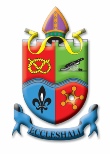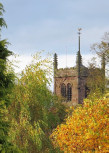Eccleshall Guide
www.eccleshallguide.org Updated 23rd September 2023

Eccleshall Guide
25 Wheelwright Drive, Eccleshall, Staffs, ST21 LB
01785 851381 07815 419166 email: peterwjones@btinternet.com
Home Platinum Jubilee  guide a-
guide a-
about the guide festival councillors 2020 photos past citizens 2019 pics old eccleshall

The History of Eccleshall
Where do the symbols on the Eccleshall Town crest come from?
The four quarters on the shield are the Stafford Knot, the Fleur-
The five pointed symbol represents the fact that Eccleshall is situated at the junction of five roads, five lines of communication. The particular symbol was taken from a half penny coin dated 1666 found in the front garden of a house in High Street.
The cannon represents the battle between the Roundheads and the Cavaliers when Cromwell’s Roundheads fired their cannon (from the current cricket ground) at the castle, where King Charles’s cavaliers had taken refuge.
The Fleur-
The embattlements on the shield symbolise the fact that a castle has stood in Eccleshall since King John’s reign and has been very important to the life and development of the town.
The bishop’s mitre symbolises the association between the bishops of Lichfield and Eccleshall based at Eccleshall castle, which from st Chad’s time was an ecclesiastical manor. St Chad had the manor AD669 until 1877, the Bishop of Lichfield resided in Eccleshall. The wavy blue line represents the River Sow and the green background represents the countryside.
According to the Domesday Survey, Eccleshall in 1086 was no more than a small village of about one hundred inhabitants.
A few fragments of stone at the base of the tower of the present Parish Church of Holy Trinity suggest that a stone church was in existence about this time and the base of the 10th century cross still stands outside the church.
The oldest part of the church , the pillars and arches of the nave were begun in 1180 while the remainder of the church was completed during the 13th century, with a fine clerestory being added in the 15th century
.
The War of the Roses
Eccleshall briefly played a part in the War of the Roses, when the castle was used as a base for the Lancastrian Queen Margaret of Anjou and her troops before and after her defeat at the battle of Blore Heath in 1459.
Medieval Eccleshall
To the Bishops of Lichfield, Eccleshall was conveniently situated on the main road between the centres of the diocese in Chester, Lichfield and Coventry.
In 1200 Bishop Geoffrey Muschamp was granted a ‘licence to crenellate’ the castle by King John. However the ruins which exist today are those of the castle built in 1305 by Bishop William Langton, a friend of Edward 1 and later Chancellor of England.
This was the great era of castle building and he built an imposing fortress with four corner towers and a wide moat.
Like many such settlements at this period, Eccleshall became important as a market town for the surrounding area. In 1153 it was granted the right to hold a weekly market and by 1259 had obtained a charter to hold an annual fair at Ascentiontide. Around the beginning of the 13th century the village had become a town with the granting of ‘Borough’ status.
By the time of the survey of the Bishop’s estates in 1298 about five hundred people lived in the village, mainly craftsmen or engaged in agriculture.
The Civil War
In June 1643 the castle was besieged by Sir William Brereton and his Parliamentary forces encamped around the church.
Their guns caused considerable damage to the walls but the castle held out. When the Parliamentary forces finally took the castle on August 30th they found that the Bishop had died of a heart attack during the siege and most of the defenders were either drunk or had gone into town drinking in the taverns.
The castle was sacked but enough of the building remained to be used as a prison for Royalist gentry.
Excavations in the moat have revealed a large quantity of 16th century and early 17th century pottery and glassware, presumably dumped as a result of the siege and sack of the castle.
It is now on display in the Stoke on Trent City museum.
During the 1690’s the castle was rebuilt in its present form as a large comfortable country house and later in the 18th century the moat was drained and the gardens laid out.
The Coaching era
With the development of turnpike trusts in the 18th century as a method of financing road building and improvements, coach travel throughout England had become faster and more reliable.
With its position on the main London -
Decline during the 19th century
Gradually during the 19th century Eccleshall lost its importance in the communications network. By 1812 the Irish Mail ran along the present A5 road to Holyhead and in 1837 the railway, like the canals before, by-
Eccleshall today
The small country town of Eccleshall, seven miles north west of Stafford is predominantly a pleasant residential town for people working in Stafford, the Potteries and further afield.
However the presence of a castle, the large church, the wide High Street with its covered arcades, once the site of a butter market, and many fine 18th and 19th century buildings all points to Eccleshall having played a more important role in the past.
Early reference
The earliest reference to Eccleshall is in the Domesday Book of 1086. From this and the name itself Ecleshelle we can imply something of its early history. The ‘eccles’ part of the name is a Romano-
The Domesday Book tells us that the Eccleshall estate had been given to the Bishop of Lichfield some time before the Norman Conquest, possible as early as the 7th century,
By the time Bishop Lonsdale died in 1867 the lack of a railway was one of the main reasons that his successor Bishop Selwyn gave for the decision to sell the castle and thus sever the long association of Eccleshall with the Bishops of Lichfield. At the beginning of the last century the castle passed into the hands of the present owners, the Carter family.
For three centuries leather working and shoemaking had been important domestic industries in Eccleshall, but by the end of the 19th century these too had almost ceased, with the growth of the mechanised shoe factories in Stafford.
Glass making in Eccleshall
During the 16th century Eccleshall became the principal seat of the Bishops of Lichfield. One of them William Overton (1580-
During the Elizabethan period there was great demand for the large windows of many mansions and smaller manor houses, being built all over England, as well as for glass vessels. By 1615 however, legislation against the use of wood for glass manufacture forced the glass furnaces to close and the workers moved to Newcastle-